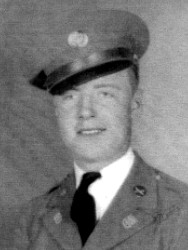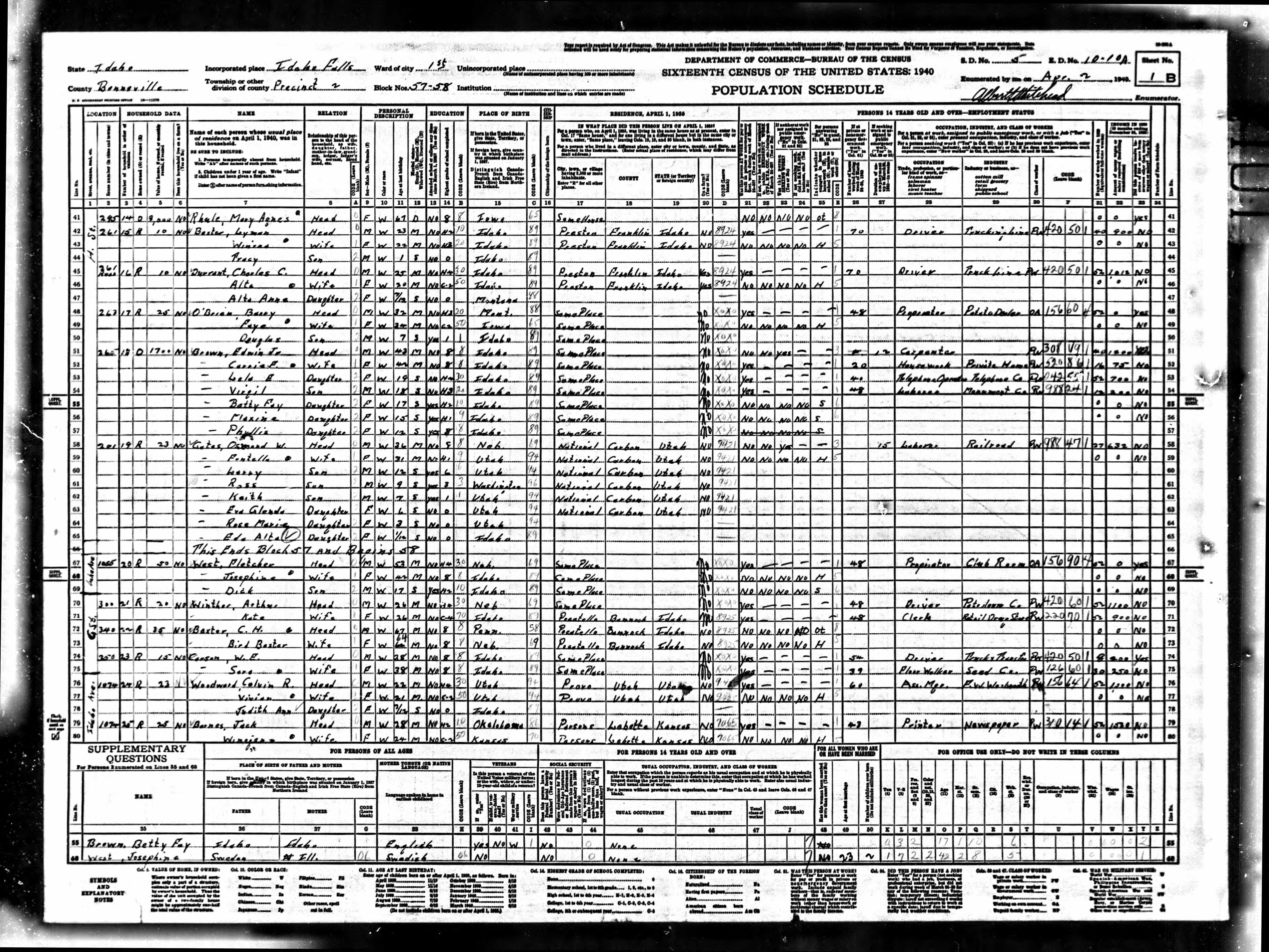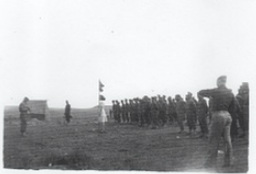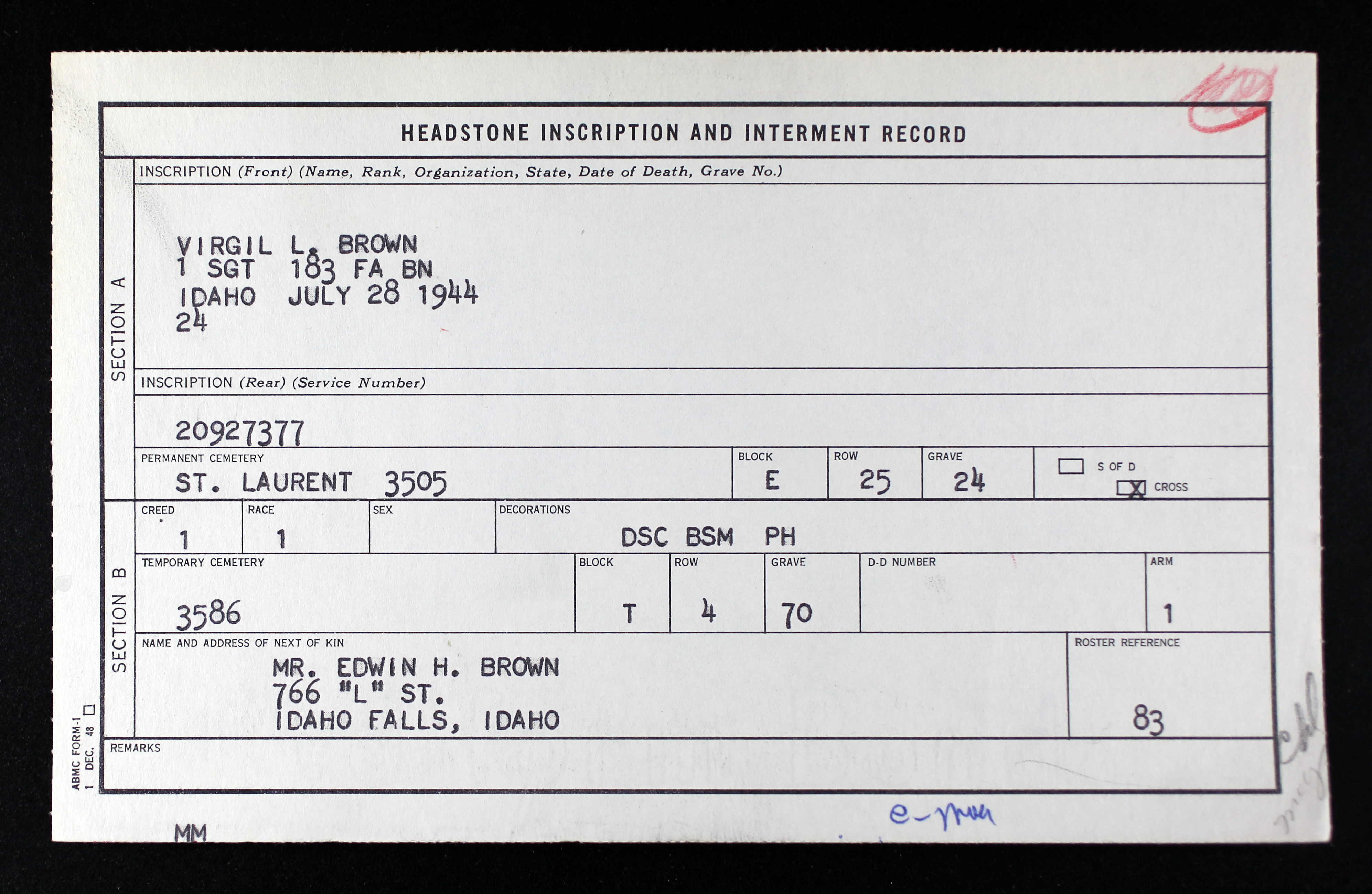First Sergeant Virgil Lowell (“Bud”) Brown

- Unit: 183rd Field Artillery Battalion, Battery B
- Service Number: 36074292
- Date of Birth: August 31, 1921
- Entered the Military: November 30, 1939
- Date of Death: July 28, 1944
- Hometown: Idaho Falls, Idaho
- Place of Death: Pont Brocard, France (near Sainte-Lô)
- Award(s): Distinguished Service Cross, Bronze Star, Purple Heart
- Cemetery: Plot E, Row 25, Grave 24. Normandy American Cemetery, Colleville-sur-Mer, France
Mentored by Mrs. Kelly Smyth
Thomas Jefferson Charter School
2012-2013
Early Life
Virgil Lowell Brown, known as “Bud” to his friends and family, was born to Edwin and Carrie Brown in September 1921. He grew up in Idaho Falls, Idaho, as the second child of five and the only son. He had an older sister, Lela, and three younger sisters, Betty, Maxine, and Phyllis. The 1930 census listed the family living on H Street. Edwin supported his family working as a laborer at a lumber yard.
Virgil attended Idaho Falls High School, where he played halfback on the football team.
In 1940, he worked as a laborer and joined the Idaho National Guard. He enlisted in the U.S. Army in 1941.


Homefront
Small Farming Community
Idaho Falls was a small farming community whose main population lived outside of the actual township. Farmers grew potatoes as their staple crop. The town consisted of an ice cream parlor, burger joint, post office, elementary school, a library, and some churches. In the 1940s, Idaho Falls was recovering from the Great Depression.
Community Loss
Details of the war did not often reach Idaho Falls, but the populace knew what was happening and knew that their young sons, daughter, husbands, wives, fathers, and mothers were involved deeply. By the end of the war, 69 young men from Bonneville County were Killed In Action or Missing in Action.
Military Experience
Brown trained with the 183rd Field Artillery Battalion stateside from 1941 to 1943. Stationed in several locations around the country, he was sent to Yakima, Washington. Lela, Brown’s older sister, and her husband, Glenn Manion. Manion recounted:
Lee [Lela] and I visited Bud when he was on bivouac at Yakima, Washington from his base at Fort Lewis, Washington. We rented an apartment with a kitchenette containing a large refrigerator that we stocked with an ample supply of cold beer. We invited Bud and his friends from the base to come spend the evening. He showed up with three fellow non-commissioned buddies and, of all people, the C.O. himself. Needless to say the beer was dispensed with in short order…understandably when one considers the environment of that sandy, hot and dusty artillery training range there on the desert out of Yakima where the fellows had been training all day in the hot sun. That evening Bud’s buddies were kidding him about being a lowly corporal. I wondered because I thought he was already a first sergeant. Seems he lost his rank for beating up an MP [military police]. He fell asleep out on a bench in the bus depot when an MP came along and whacked him across the soles of his feet with his nightstick. Bud, not fully awake, comes up off the bench and nearly beats the guy up before the other MP (they always traveled in pairs) was able to separate them. He was well liked by his fellow comrades and by his officers as well. This was apparent because it wasn’t long before his rank of first sergeant was restored.
While in Washington, Bud met his future wife, Betty Jean Wyatt Laidler, and her young son, Gary, from a previous marriage. They were married on February 3, 1943, in Idaho Falls, Idaho.
According to Manion, Gary was a smart, happy-go-lucky boy who loved his new grandfather, Edwin. He last saw his family on his final furlough in October 1943. His family visited him with his unit in Pocatello, Idaho, on a night when his unit camped in a vacant field on their way back to Fort Lewis. Manion reflected on this short visit. “I’m certain what little time Ed [Bud’s father] and Carrie [Bud’s mother] had with their son was well worth the late hour and the cold night. Driving home that night I noticed no one did much talking. All with thoughts of the events of that special night. Through my mind ran that strains of ‘… and the caissons go rolling along.’”
Aptitude for Military Life
Brown remained in the U.S. until October 19, 1943, and continued to write to his family. His younger sister, Betty Faye, kept these letters until her death in 2009. The family received nine letters from England from February 8, 1944, to July 20, 1944. The letter dated July 20 was Virgil’s last letter home. In his letters, especially the ones from overseas, Virgil wrote: “about the weather, how hard training was, and asked questions on how everyone was.” Once he asked to be sent a carton of chewing gum saying, “these darn Limeys don’t know what a stick of gum is.”
Operation Cobra
On July 28, 1944, First Sergeant Virgil Brown was with his artillery battalion, Battery B of the 183rd Field Artillery Battalion. They were ordered to hold their position to support the men who took control of Sainte-Lô. When attacked from behind by German forces, the men found themselves pinned down by a machine gun nest. His Distinguished Service Cross citation reads:
Observing an unexpected attack which threatened the rear of the battery, First Sergeant Brown, with complete disregard for his own safety, courageously led his men through incessant automatic weapons and small arms fire in a vicious counterattack. Surprised by a sudden burst of fire from a well-concealed machine gun, First Sergeant Brown, daringly charged the gun emplacement. Although seriously wounded by a burst of fire from the gun, he continued his heroic advance until he was again hit and mortally wounded.


Eulogy
Notifying the Family
Brown’s sisters, Maxine and Betty Faye, were in town when they were alerted by a friend that a telegram was sent to the family’s home. The family held a memorial service at the 1st Ward L.D.S. Church in Idaho Falls, Idaho. Bishop Harold Bishop oversaw the service, which had music by the 1st Ward Choir. The songs “The Lord is My Shepherd,” “When Dark and Dreary Skies Appear,” and “Abide With Me” were performed. Melvin Harris sang a solo, “The Flag without a Stain,” in his honor, and Dr. H. Ray Hatch spoke. The American Legion presented a flag to Mrs. Carrie Brown.



Bibliography
Primary Sources
Brown Family Photographs, 1921-1944. Courtesy of Glenn and Larry Manion.
Idaho. Bonneville County. 1930 U.S. Federal Census. ancestry.com.
Idaho. Bonneville County. 1940 U.S. Federal Census. ancestry.com.
Marriage ID#151755. Special Collections & Family History, Brigham Young University, Idaho. Accessed January 8, 2021. abish.byui.edu/specialCollections/westernStates/westernStatesRecordDetail.cfm?recordID=151755.
Spearhead in the West…: The Third Armored Division. Unit History. 1946. www.3ad.com/history/wwll/spearhead.west.index.htm.
“Two Marriage Licenses.” The Post-Register [Idaho Falls, Idaho], February 4, 1943. Newspapers.com (81842960).
Virgil Lowell Brown. Headstone and Interment Records for U.S. Military Cemeteries on Foreign Soil, 1942-1949. ancestry.com.
Virgil Lowell Brown. Idaho Marriage Records, 1863-1967. ancestry.com.
Secondary Sources
“1Sgt Virgil Lowell Brown.” Find a Grave. Updated August 8, 2010. Accessed January 8, 2021. www.findagrave.com/memorial/56642731/virgil-lowell-brown.
Manion, Larry. Interview with the author, May 6, 2013.
Stanton, Captain Shelby L. World War II Order of Battle, U.S. Army. Mechanicsburg: Stackpole, 2006. Print.
“Virgil Brown.” American Battle Monuments Commission. Accessed January 8, 2021. www.abmc.gov/decedent-search/brown%3Dvirgil.

